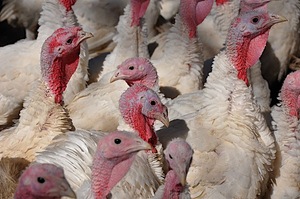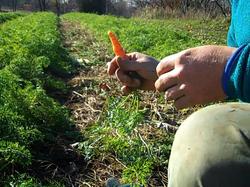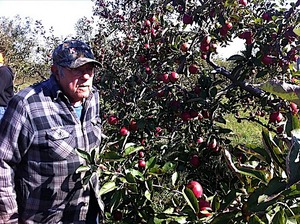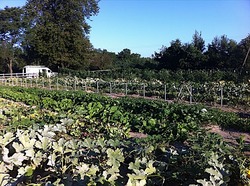Who knew? I am a domestic terrorist for taking pictures of farms.
/
"Have you heard about the Slow Food campaign? They are urging supporters to send in pictures of farms to protest against the Florida, Iowa, and Minnesota bills that would make it illegal to take a picture or a video of a farm. They are calling it the farmarazzi campaign." Two weeks ago, I am sharing the news with a fellow breakfast diner at a noisy table at SELMA Breakfast Salon.
"I don't like to hear the word Nazi, that word upsets me."
Nazi, how did we get to Nazi? I am talking about a photo campaign to protest bills, not gassing trainloads of children and systemic fear mongering by the state.
"Oh no, you misheard, I don't like that word either," I slow down and raise my voice, "fffaaarrrmarazzi. Like paparazzi, but farm-a-razzi."
Two weeks later, Slow Food USA has collected more than 33,000 signatures for their campaign, 450 pictures of farms, the legislation has been "indefinitely postponed" in Florida, and Slow Food continues to collect pictures and signatures - urging supporters to contact legislatures.
I recently asked Jerusha Klemperer from Slow Food USA what prompted them to start the farmarazzi campaign in the first place. Klemperer shared, "We first noticed this legislation after it was covered on NPR, and then saw the coverage and concern grow... A well-managed farm should have nothing to hide. Slow Food has always been about connecting producers and consumers so that each can understand each other and build a relationship."

Prompted by Slow Food's campaign, and Klemperer's sentiments, I set about trying to understand more. I became curious as to where this legislation came from. I couldn't stop wondering why three states would all propose the same type of legislation, at the same time, with very similar words.
In the last decade, there seems to be a growing trend to represent animal activists as terrorists. The Ag-Gag bills, as described by Mark Bittman, are the latest addition to this trend. Let us explore the trend and the history that got us here.
In 2003, the FBI received their audit from the Justice Department's Office of the Inspector General that stated:
Consider transferring responsibility for investigating crimes committed by environmental, animal rights, and other domestic radical groups or individuals from the Counterterrorism Division to the Criminal Investigative Division, except where a domestic group or individual uses or seeks to use explosives or weapons of mass destruction to cause mass casualties.
Thank you, Will Potter of Green is the New Red, for bringing this to my attention. (You can read the full audit here.)
The recommendation states that in 2003 animal right "radical groups" are being investigated under the "Counterterrorism Division." In a March 2008 Fox News article entitled FBI: Eco-Terrorism Remains No. 1 Domestic Terror Threat, it is argued that "for years, officials have battled against members of shadowy groups such as the Earth Liberation Front and its brother-in-arms, the Animal Liberation Front. Law enforcement has made strides prosecuting cells."

Where is the line between domestic activism and terrorism? To the FBI it is a narrow (perhaps invisible) line. A May 2011 Wall Street Journal's opinion piece speaks to the seeming disparity of having an animal activist rub elbows with mass murderers in the FBI's "Ten Most Wanted Terrorists" list. But the FBI is just following the legislative lead from Congress.
In 2006, the Animal Enterprise Terrorism Act (AETA) was passed to "provide the Department of Justice the necessary authority to apprehend, prosecute, and convict individuals committing animal enterprise terror... for the purpose of damaging or interfering with the operations of an animal enterprise." The law specifically states that it shall not be construed "to prohibit any expressive conduct (including peaceful picketing or other peaceful demonstration) protected from prohibition by the First Amendment of the Constitution."
Words have power. The word "terror" is terrifying and our government seems happy to use it often.
Yet for someone working in an animal testing facility I can understand that it would be horrible to have your office bombed. It would be mind-numbingly awful to have insulting slogans painted on your car or home, a total invasion of your sense of security (read here about activities and arrest of 7 activists targeting one of the largest animal testing laboratories in the UK courtesy of The Guardian).
Is terrorism just "mass destruction"? What constitutes mass? More than 100 people in an office? 30 animal testing labs? 5 factory farms with 40,000 birds? This is a quagmire. Our latest addition to the "animal activist = terrorist" trend are the Ag-Gag Bills proposed in Florida, Iowa, and Minnesota.
According to my lawyer friends, the argument in support of the Ag-Gag bills is this. I apply to work in a chicken farm. I take pictures or a video of animals being cruelly mistreated. I post the video on my website. Consumers are so disgusted by what they see that they stop purchasing eggs from that farm and someone breaks in to the facility to free the chickens.

Sharing the information I found gives others a reason to act. I am facilitating criminal activities even though it is not my intent. I have then committed "animal facility interference" (as defined by the Minnesota Ag-Gag Bill, House File No. 1369) and the loss of revenue and potential threat of theft is certainly "interfering with the operations of an animal enterprise" according to AETA. The Iowa Ag-Gag Bill, Senate Fill No. 431 states this conspiracy relationship clearly:
A person who participates in a conspiracy to commit the offense of animal facility tampering, and who acts in furtherance of that commission, is guilty of the same offense as the person convicted of committing the offense on or in the animal facility.
In April 2010, the Humane Society posted a video they had created by going undercover at two chicken farms using the same methods I outlined above. It is a very disturbing video (here is the link if you want to see it) and it would be illegal under these proposed bills.
John Maday, managing editor the nation's oldest monthly livestock magazine Drovers, argued in February 2011 in response to the proposed Ag-Gag legislation that:
We need more transparency in agricultural production. In reality, the vast majority of livestock operations are well-managed, with owners and workers adhering to high standards of animal care. Consumers do want to know more about their food and where it comes from, and when they have a chance to see and experience modern livestock production first-hand, they typically come away with positive impressions.
For farmers and ranchers, the focus should not be on legislation or other means of concealing their production practices. Instead, they should engage the public with a policy of transparency.
Thank you Slow Food USA for bringing this to my attention and for your campaign. Thank you John Maday for your belief in "a policy of transparency" for our farms. Thank goodness I am not the only observer of this trend not sure we are heading in the right direction.
Here is the article on Real Time Farms!




